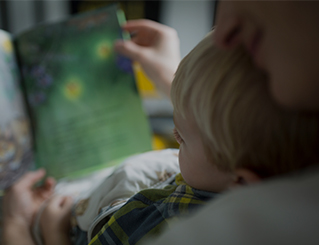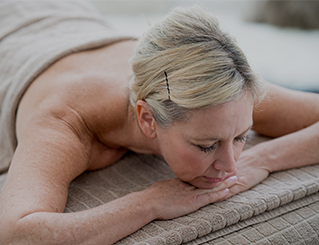While new babies may be tiny, their needs are anything but! Caring for them is actually a very physical job – lifting, carrying, holding, diapering, dressing, feeding, and more. Many new parents end up feeling sore, so adjusting to these repetitive new motions can be especially problematic for parents living with rheumatoid arthritis (RA)
As someone with RA and three children of my own, I’ve learned a lot about what works and what doesn’t through the process of trial and error. I’ve also brainstormed with many other mamas living with RA, including Cheryl, a friend who is not only a mom with RA herself, but also a trained occupational therapist. As she reminded me, it can be easy to focus so much on the baby’s needs that you forget to consider what might be best for you! So I’d like to share some personal strategies and life hacks to help you tackle parenting a new baby when you’re living with RA.
Set up your house to help
Before baby arrives, some preparations at home can be useful. For parents with RA, I think one of the best things you can do is make sure there are plenty of safe places to put baby down whenever you need to. In addition to a crib in the nursery, I had a pack and play, swing, and various bouncy seats spread throughout the house. I also relied heavily on the co-sleeper in my bedroom, which is like a mini crib that attached securely to the side of my bed. Having my baby literally within arm’s reach while I was sleeping allowed me to get more rest. I also set up a changing area on each floor of my house so I wouldn’t have to waste energy carrying my children upstairs every time they needed changing–which is 10 to 15 times a day in the first few months!
“It can be easy to focus so much on the baby’s needs that you forget to consider what might be best for you!”
Diapering
Before you decide where to change your baby, Cheryl recommends thinking about the ergonomics of your changing area by considering the joints that give you the most trouble. If your main issues are knee or hip pain, changing your child on a higher surface may work best. For some people, bending down to change diapers on the floor may actually be easier as you won’t have to lift a heavy baby with sore hands or wrists. I know another mama who said buying a corner changing table changed her life because she found it easier to have the baby facing straight instead of turned to the side. Once you decide what changing location and position works best for you, make sure you have all of your supplies within easy reach of that area – including wipes, clean diapers, and diaper cream if needed.
Dressing
Unfortunately, the vast majority of baby clothes seem to come with lots of tiny snaps, which are very unfriendly to those of us having trouble with our finger joints! While I could usually manage a couple snaps on the bottom of a onesie, I found snaps to be most frustrating on footie pajamas, where there would be six or eight of them to line up and snap up after every diaper change in the middle of the night. So when my second kiddo was born, I donated all the jammies with snaps and replaced them with zippers. I also know a few mamas who swear by baby clothes with magnetic closures.
Feeding
New babies need to be fed often – at least eight times a day in the first three months! This makes it particularly important to make sure you are feeding your baby in a comfortable position that doesn’t put additional strain on your body. Regardless of whether you are breastfeeding or bottle-feeding, a nursing pillow can be very useful to help maintain proper positioning and minimize the strain on your shoulders.
If you are breastfeeding, Cheryl recommends testing out the closure systems on nursing bras and tanks to make sure your fingers can handle them, and wearing loose-fitting clothing or a robe if they’re too difficult. If you plan to use a breast pump, we both highly recommend a special bra to help hold the pump parts in place without strain. If you’re bottle-feeding, keep in mind that finding the right bottle can be a process, since it will depend on your own needs and what your baby prefers. I found a wider bottle easier to hold, while other friends chose narrow ones. You may also want to keep in mind how easy the bottle parts are to wash.
Car seats
Obviously the primary intent of a car seat is to keep your baby safe, but for parents with RA car seats can be particularly difficult for sore hands and bodies to handle. Unfortunately, there isn’t a one-size-fits-all answer to this question, so I’d recommend visiting a baby store that has lots of options and checking out a bunch of car seats yourself before making a choice. Test how easy it is to open and close the buckles. For many parents with RA, car seat buckles can be very difficult to open. If you’re choosing an infant seat that will be taken in and out of the car, test how heavy it is, how easily it comes in and out of the base, and figure out the best way to carry it.
Strollers
I think a good stroller is a must-have item for any RA parent. A stroller can make it easier to move an infant car seat and minimizes how often you have to open and close the car seat buckles. One option is a dedicated infant car seat carrier. These tend to be extremely lightweight and easy to maneuver, but the downside is that they are no longer useful once your baby grows out of their infant car seat. The second option is a convertible stroller or travel system, which can hold the infant car seat and can also be used as a stand-alone stroller. I personally preferred the second option, but keep in mind this type of stroller can get very heavy. As you’ll likely be hauling the stroller in and out of your car several times a day, make sure you do your research. No matter what type of stroller you choose, I also recommend testing how difficult it is to fold and unfold.
Babywearing
There can be many benefits to babywearing, but for parents with RA it can offer a way to hold and carry your baby even if your hands or wrists are flaring. Personally, I couldn’t even imagine motherhood without babywearing! Baby carriers generally fall into a few categories: wraps, mei tais, ring slings, and soft structured carriers. In general, wraps and mei tais can be a bit more difficult for parents with RA as they require manipulating fabric and tying knots. I personally loved using a ring sling for quick errands or breastfeeding on the go, but they can also be problematic for people with RA since they place all the baby’s weight on one shoulder.
If you are new to babywearing and have RA, a soft structured carrier may be the best place to start. These carriers feature adjustable buckles and straps, which are usually easier to manage than tying knots. There are many different brands, and each will fit and function a little bit differently, so I’d recommend trying on several styles before deciding. A baby boutique is a great place to try on carriers. If you plan to wear your baby often, Cheryl points out that it may be useful to have a few different types of carriers so you don’t cause repetitive stress to one area of your body, and I certainly agree!
Seek help if you are struggling
As I mentioned at the start of this article, caring for a baby is physically demanding for anyone. If you ever reach a point where your RA is making it difficult to perform basic or essential tasks for your baby, it’s time to ask for help. Medical professionals can provide many options for minimizing current pain and preventing future pain. Occupational therapists like Cheryl can help you troubleshoot specific tasks. And don’t be afraid to ask your partner, parents, siblings, or friends if you need an extra hand. Raising a baby takes a village – so make sure to make use of yours!
Like this article? Get even more from Arthritis.com. Register today for the latest updates, articles, tools, and more!









